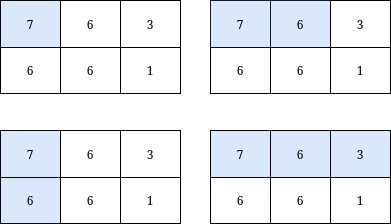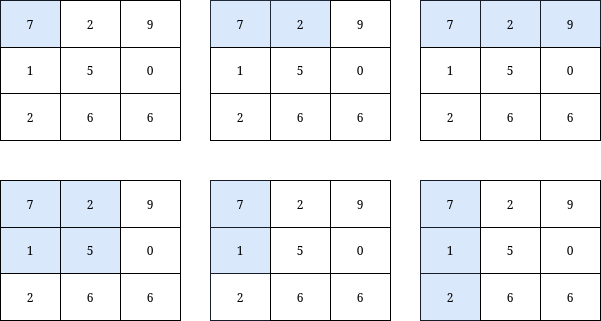Count Submatrices with Top-Left Element and Sum Less Than k
MediumUpdated: Aug 2, 2025
Practice on:
Problem
You are given a 0-indexed integer matrix grid and an integer k.
Return thenumber of submatrices that contain the top-left element of the
grid, and have a sum less than or equal tok.
Examples
Example 1

Input: grid = [[7,6,3],[6,6,1]], k = 18
Output: 4
Explanation: There are only 4 submatrices, shown in the image above, that contain the top-left element of grid, and have a sum less than or equal to 18.
Example 2

Input: grid = [[7,2,9],[1,5,0],[2,6,6]], k = 20
Output: 6
Explanation: There are only 6 submatrices, shown in the image above, that contain the top-left element of grid, and have a sum less than or equal to 20.
Constraints
m == grid.lengthn == grid[i].length1 <= n, m <= 10000 <= grid[i][j] <= 10001 <= k <= 10^9
Solution
Method 1 – Prefix Sum Brute Force
Intuition
We want to count all submatrices that start at the top-left (0,0) and end at (i,j) for all i, j, such that the sum of the submatrix is less than or equal to k. By precomputing prefix sums, we can quickly get the sum of any such submatrix.
Approach
- Compute a prefix sum matrix where each cell (i, j) contains the sum of the submatrix from (0,0) to (i,j).
- For every possible bottom-right corner (i, j), calculate the sum of the submatrix from (0,0) to (i,j) using the prefix sum.
- If the sum is less than or equal to k, increment the answer.
- Return the total count.
Code
C++
class Solution {
public:
int countSubmatrices(vector<vector<int>>& grid, int k) {
int n = grid.size(), m = grid[0].size(), ans = 0;
vector<vector<int>> ps(n+1, vector<int>(m+1));
for (int i = 1; i <= n; ++i) {
for (int j = 1; j <= m; ++j) {
ps[i][j] = grid[i-1][j-1] + ps[i-1][j] + ps[i][j-1] - ps[i-1][j-1];
if (ps[i][j] <= k) ans++;
}
}
return ans;
}
};
Go
type Solution struct{}
func (Solution) CountSubmatrices(grid [][]int, k int) int {
n, m := len(grid), len(grid[0])
ps := make([][]int, n+1)
for i := range ps {
ps[i] = make([]int, m+1)
}
ans := 0
for i := 1; i <= n; i++ {
for j := 1; j <= m; j++ {
ps[i][j] = grid[i-1][j-1] + ps[i-1][j] + ps[i][j-1] - ps[i-1][j-1]
if ps[i][j] <= k {
ans++
}
}
}
return ans
}
Java
class Solution {
public int countSubmatrices(int[][] grid, int k) {
int n = grid.length, m = grid[0].length, ans = 0;
int[][] ps = new int[n+1][m+1];
for (int i = 1; i <= n; ++i) {
for (int j = 1; j <= m; ++j) {
ps[i][j] = grid[i-1][j-1] + ps[i-1][j] + ps[i][j-1] - ps[i-1][j-1];
if (ps[i][j] <= k) ans++;
}
}
return ans;
}
}
Kotlin
class Solution {
fun countSubmatrices(grid: Array<IntArray>, k: Int): Int {
val n = grid.size
val m = grid[0].size
val ps = Array(n+1) { IntArray(m+1) }
var ans = 0
for (i in 1..n) {
for (j in 1..m) {
ps[i][j] = grid[i-1][j-1] + ps[i-1][j] + ps[i][j-1] - ps[i-1][j-1]
if (ps[i][j] <= k) ans++
}
}
return ans
}
}
Python
class Solution:
def countSubmatrices(self, grid: list[list[int]], k: int) -> int:
n, m = len(grid), len(grid[0])
ps = [[0]*(m+1) for _ in range(n+1)]
ans = 0
for i in range(1, n+1):
for j in range(1, m+1):
ps[i][j] = grid[i-1][j-1] + ps[i-1][j] + ps[i][j-1] - ps[i-1][j-1]
if ps[i][j] <= k:
ans += 1
return ans
Rust
impl Solution {
pub fn count_submatrices(grid: Vec<Vec<i32>>, k: i32) -> i32 {
let n = grid.len();
let m = grid[0].len();
let mut ps = vec![vec![0; m+1]; n+1];
let mut ans = 0;
for i in 1..=n {
for j in 1..=m {
ps[i][j] = grid[i-1][j-1] + ps[i-1][j] + ps[i][j-1] - ps[i-1][j-1];
if ps[i][j] <= k {
ans += 1;
}
}
}
ans
}
}
TypeScript
class Solution {
countSubmatrices(grid: number[][], k: number): number {
const n = grid.length, m = grid[0].length;
const ps = Array.from({length: n+1}, () => Array(m+1).fill(0));
let ans = 0;
for (let i = 1; i <= n; ++i) {
for (let j = 1; j <= m; ++j) {
ps[i][j] = grid[i-1][j-1] + ps[i-1][j] + ps[i][j-1] - ps[i-1][j-1];
if (ps[i][j] <= k) ans++;
}
}
return ans;
}
}
Complexity
- ⏰ Time complexity:
O(n * m)for prefix sum calculation and checking each submatrix starting at (0,0). - 🧺 Space complexity:
O(n * m)for the prefix sum matrix.